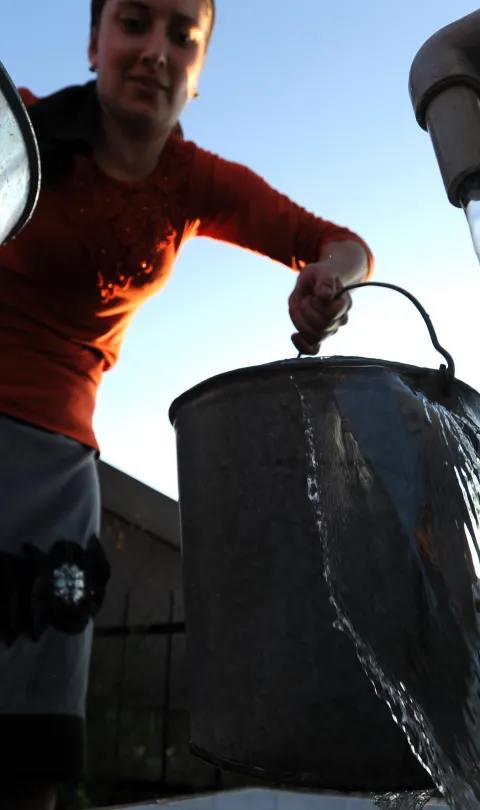Much like water, data is all around us. And much like water, data is an invaluable resource that leads to better development outcomes. So for the past decade, the World Bank’s Open Data Initiative has provided free, open access to the Bank’s development data and supported countries to launch their own data initiatives.
Data allows us to build the clearest picture, harness the best evidence and make informed decisions to achieve a water-secure world. And when it comes to water, decisions based on data can greatly improve service delivery, sustain water resources, and build resilience.
That’s why, with support from the Global Water Security & Sanitation Partnership (GWSP), the World Bank has just launched the World Bank Water Data Portal. For the first time ever, a curated list of water data from the World Bank and other sources and institutions is now available in one place. This has meant sourcing from World Bank-funded initiatives such as the International Benchmarking Network for Water and Sanitation Utilities (IBNET), the Rural Water and Sanitation Information System (SIASAR) and the Global Facility for Disaster Reduction and Recovery (GFDRR) and supplementing that with dozens of quality data sources such as the OECD, the UN, World Resources Institute, the World Wildlife Fund, and a number of governments.
The demand for the portal stemmed largely from two places.
Firstly, requests from World Bank client countries for data to help tackle some common development challenges. All too often, our staff in different countries with completely different contexts would receive remarkably similar questions from their counterparts in government — where might new irrigation techniques be most effectively applied?; how to most effectively target sanitation projects to tackle waterborne diseases?; what specific parts of the country were most impacted by water pollution? Much of the data that could help with these questions was available but in a number of different places.
Secondly, insights and evidence from our own global research and analytics. Our 2019 report Quality Unknown showed us just how fundamental reliable information is to the social contract in general and to tackling water pollution specifically. It revealed how better information disclosure could not only improve decision-making at the household level — for example, if people know water from a certain well has a higher concentration of arsenic, they will get their water from elsewhere — it could also inspire citizen engagement and social movements. So we knew just how key a role data can play.
The portal has been designed and will be maintained in line with two key principles.
Firstly, the principle of moving from fragmentation to organization. Water datasets are everywhere but it is precisely this deluge of data that can often make it challenging for researchers or decision-makers to seek out the information they need. That’s why this portal collates, aggregates, and catalogs what we believe are among the most robust datasets publicly available and provides the world’s largest warehouse of water data.
Users can quickly search the data in several ways:
- By country, so that it can be applied to their specific national challenges or goals and be of use to local and national-level civil society. This data can include everything from progress towards the Sustainable Development Goals (SDGs) to public opinion surveys.
- It is also presented on a regional level, which we believe will be of particular use to multilateral institutions looking for a big-picture regional view.
- Data is also available via the three pillars of sustaining water resources (this includes data on the quantity and quality of surface and groundwater, water scarcity, and transboundary issues), delivering services (this includes data on water utilities, irrigation, institutions, and water supply and sanitation infrastructure), and building resilience (this includes data related to resilient infrastructure like dams and seawalls and extreme climatic events like floods, storms and droughts.)
Secondly, the principle that active contribution leads to improved consumption. Simply put — the more that people contribute to the portal, the more useful it will be for everyone and the more it will help shape decision-making. After all, as the CEO of the Global Partnership for Sustainable Development Data, Dr. Claire Melamed, recently pointed out, “data is useless unless it’s used.”
We hope this portal incentivizes users to become contributors and begin to share their datasets with us to make the portal even more representative, comprehensive, and accurate. And we believe that data is both a resource and a rallying cry. The first step to tackling the water challenge is recognizing the scale of it. To quote former UN Secretary General Kofi Annan: “Without good data, we’re flying blind. If you can’t see it, you can’t solve it.”
The world needs reliable, accurate, and wide-ranging data so that new insights can be discovered, decision-making can be evidence-based, and citizens can call for action. Encouraging and enabling this information and its sharing is critical to transforming the next big idea into a water-secure world for all. This portal might be just the place to start.
